Introduction
This study’s central focus was the current vaccination issue in relation to the COVID-19 pandemic sweeping the world. It is known that large numbers of patients worldwide refuse vaccines for religious, ethical, medical, or personal reasons. Among the most unexplained factors are often cited conspiracy aspects, whether the world government desires to control humanity through 5G chips or, conversely, to drastically reduce the population by inoculating a killing agent (Jolley and Paterson, 2020). In an attempt to explore the underlying social constructs of vaccine use more deeply, a research question has been constructed that is phrased as follows: “Determine the number (percentages, raw count) of COVID-19 vaccination acceptance or refusal among medical personnel from the Republic of Moldova.”
Research Objectives
Given the complexity and multifactoriality of the research question, it was decided to break it down into sequential tasks whose solution contributed to the flow of the research project. The following five tasks were set and subsequently solved:
- Conduct a literature review of current sources released no earlier than 2017, using digital databases in English.
- Conduct a structured questionnaire survey of respondents using closed-ended questions and collect data.
- Using MS Excel as a statistical tool, critically process the collected data and create an appropriate, user-friendly, and attractive visualization of the resulting trends.
- After obtaining the results of statistical processing of the questionnaire data, propose recommendations for public awareness of the COVID-19 vaccination problem.
Research Design
This research project was based on a quantitative research approach, the use of which addressed the previously stated research question. It was a cross-sectional survey that captured trends for a specific sample at a specific point in time. It is important to emphasize that this research design, as well as the results obtained, was not used to predict or establish causal relationships: thus, it is an excellent approach for quantitative research that answers the categories of “how much” but not “why” and “how” (Apuke, 2017). Another motivation for choosing a particular research approach was the lack of motivation by variables. Being descriptive, the present experiment only captured common trends among respondents and attempted to describe them but did not use changes in the independent variables to test their influence on the other variables (Hunziker and Blankenagel, 2021). Looking forward, it is for this reason that linear regression and correlation models are missing from the statistical results section, as this was not feasible in the current design of the research project.
As a central data collection tool, a questionnaire made in-house specifically for the specific study was used. The questionnaire includes twenty-one closed or semi-closed questions in which the respondent is asked to choose the most appropriate answer from strictly suggested options, ignore the question entirely, or write their option, if implied, in the “Other” box. For understanding, it is essential to emphasize that the design of the questionnaire did not require each question to be completed before proceeding to the next, so participants could skip a particular question(s) if they did not want to or could not answer it.
The primary form to be completed was the consent to participate in the trial, which briefly described the vision and goals of the experiment and asked participants to answer several questions on a dichotomous scale, that is, on a “yes/no” format. At the end of this document, the respondent filled in some organizational information: Full name, date completed, any contact information to clarify questions on the questionnaire, and a signature (Informed consent guidelines, 2021). Organizational questions that could be asked additionally through channels of contact — phone, email, messengers — included, for example, a transcript of the written text, if applicable.
The first four questions of the questionnaire, from the second to the fifth inclusive, were a demographic block, asking for age range, gender, the highest degree of education, and a class of medical personnel, whether nurse or physician. The sixth question was based on a Likert psychometric scale, for which the respondent had to select their level of agreement with the statement from four options (Chyung et al., 2017). It is important to emphasize that using this question methodology allows for non-categorical respondent opinion and does not reduce the results to a dichotomous scale. Nevertheless, it is known that questionnaire test-takers tend not to give extreme answers on the scale or agree with statements without thinking about the truth of their opinions on the problem being analyzed (Jebb, Ng, and Tay, 2021). Therefore, the Likert scale was only used for question six.
The seventh and eighth questions were necessary to measure the level of vaccination awareness among the sample, including the level of awareness of it. Based on the bottom line that question #8 was answered, the respondent was asked to answer an additional, follow-up three questions #9 – #11 from question #8. The subsequent block of questions from #12 through #18 included the respondent’s need to agree or disagree with the questioning statements, using a strictly dichotomous yes/no scale. Questions in this block included but were not limited to conspiracy, public health, and political aspects of vaccination.
The last four questions, #19 through #22, were multiple-choice questions, meaning that the respondent could choose any number of options that were offered. This format did not preclude a closed-ended questionnaire design, as again, the participant was limited in their choice of answers; alternatively, the respondent had the right not to answer if they did not want to or could not. Questions in this block included a measurement of the sources of information on conspiratorial aspects of vaccination, presence of specific diseases, reasons for refusal, and COVID-19 suffered, if applicable.
The mailing of the questionnaires was preceded by adjustments to the Gatekeeper Approval Survey template. Specifically, interim changes that were made to the questionnaire design prior to mailing included expanding the demographic block, adding questions with dichotomous responses, and using a Likert scale. In this research project, the gatekeeper did not approve the use of the questionnaire until after the final edits were made, which caused the response collection timeline to be slightly shifted, but which had little effect on the overall methodological design.
Setting up the Study
A sample of Moldovan residents was collected for the current research project. Specifically, the survey was conducted among members of the student body, academics, graduate students, undergraduates, and nurses from various clinical organizations and hospitals in the Eastern European state of Moldova. The survey was not conducted among residents of a specific city, so its results may be fair for the Republic as a whole: Chisinau, Cahul, Ungheni, Causehi, and other cities.
Sample Formation
Since the current study is based on a cross-sectional summary of respondents’ opinions, it was essential to ensure that the results were minimally biased towards systematic evaluation. An analysis of the sources demonstrated that the minimum sample size to ensure sufficient validity for sociological research should not be below thirty people, so in the current design, it was crucial to gather a more significant number of respondents (Sample size formula, 2019). For this reason, eighty survey forms were prepared for the survey and sent out to all participants using the digital platforms WhatsApp, Telegram, Viber, Messenger, and email. The remote format of the questionnaire was critical in a pandemic setting, as participants’ personal presence in time for the trial was ruled out by medical safety concerns. Instead, the questionnaire form, together with a consent form to participate in the trial, was distributed to friends, acquaintances, and acquaintances of the author of the research project via electronic platforms. Participants could fill out the questionnaire electronically using a variety of tools that uniquely demonstrated their answer to each question, or they could print it out themselves, fill it in by hand, and then scan it and return it to their contact mailing address. Thus, for this trial, an incredible snowball approach to sample formation was used, where each participant was asked to invite an additional participant, but this procedure was not recorded in any way. The final outcome was a maximum sample of 40 participants; thus, the sampling rate was.50 (40 out of 80).
The total number of participants in the final sample was 40, of which two questionnaires were excluded. The only rule for the exclusion of questionnaires was the lack of adequately completed data or the inability to read the results due to their ambiguity. Thus, if a respondent indicated two items on the age question, such a questionnaire was excluded from processing as invalid, as shown in Figure 1. In addition, any questionnaire that was not filled out completely was excluded: for example, if the respondent filled out the first six questions but did not answer the questions of the central part of the questionnaire. Thus, only 38 questionnaires — the total share of.475 — were used for analysis, which is still more than the minimum threshold of sociological research.
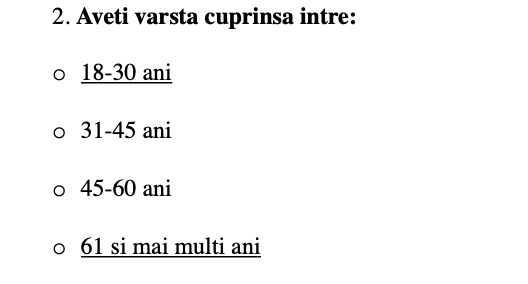
The total number of respondents was 38 of whom 84.21 percent (no. = 32) were female, and 15.79 percent (no. = 6) were male. In terms of age distribution, the majority of participants (55.26 percent or no. = 21) belonged to the 45 to 60 age group. However, an equal number of respondents (15.79 percent or no. = 6 each) belonged to the marginal distribution intervals, i.e., 18 to 30 and 61 years old. The smallest number of respondents (13.16 percent or no. = 5) were adults in the 31 to 45 age group. The level of higher education was also used to characterize the sample demographically. Specifically, 52.63 percent (no. = 20) of the participants had a master’s degree, and only 13.16 percent (no. = 5) were PhDs. Three people, 7.89 percent, stated that they were undergraduates — neither master’s nor graduate students — while ten people (26.32 percent) chose not to indicate their education.
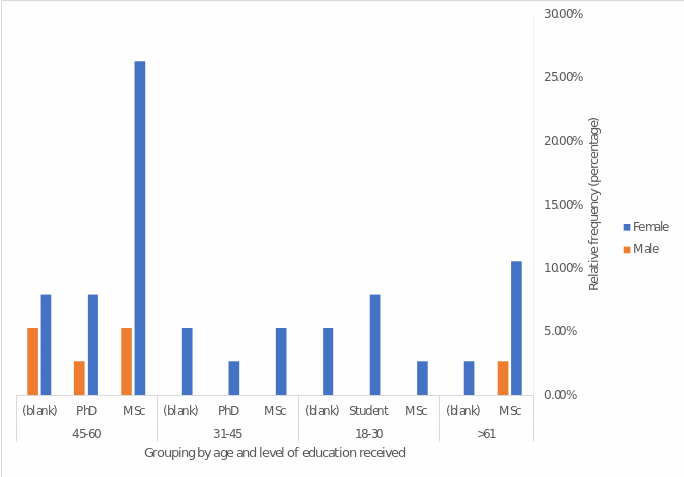
It was interesting to examine how the age and education level of respondents were related as a function of their gender. Turning to Figure 2 shows that men were present in only the oldest age groups. Moreover, of the six men, only four indicated their education as master’s (no. = 2) or graduated school (no. = 2), whereas the distribution of women by education and age is meaningfully more complete. Subsequently, this could be a significant problem because men are not represented in all strata in this sample, and a chi-square test confirms statistical differences in proportions. The overall demographic results of this sample are summarized in Table 1.
Table 1. Demographic characteristics of the generated sample (no. = 38).
The sample was created based on the inclusion and exclusion criteria that were applied to create a representative group of individuals who met the academic interests of this study. Specifically, the following conditions were used for the inclusion criteria. First, participants had to be over the age of 18, but there was no upper limit: thus, the sample was assembled from adult respondents only. Second, the participant had to belong to the medical community: it could be students of medical, educational institutions or employees of the medical complex: nurses, doctors, and any other employees. Thus, any respondents who were in no way connected with the community were not invited to participate. In addition, the survey was conducted among the Moldovan population, so a knowledge of the Moldovan (Romanian) language was not a prerequisite for inclusion. The option of sending the questionnaire in English in case the respondent requested a translation of the questionnaire, determines the non-binding character of the inclusion criterion. Looking ahead, the immediate results of the questionnaire were collected and recorded in the original language of the survey, which is Romanian, automatically translated into the language of the research project, English. Based on this, the exclusion criteria were younger age and not belonging to the medical community. The criteria applied together were intended to help create a representative sample that met the interests of the research question.
Epistemological Approach and Research Philosophy
The central focus of the philosophy of this study is the interpretivist approach, which evaluates knowledge as dependent on subjective perception. Interpretivism, as part of the research methodology, proposes to focus on details, subjective meanings, and perceived reality in order to know reality. In relation to sociological inquiry, this epistemological approach seems most appropriate since it is the one that defines knowledge as untrue, incomplete, and imperfect. Since the ultimate goal of this research project was based on identifying causes and motivations, interpretivism is a relevant philosophy. An essential component of this philosophy of methodology is the recognition of the researcher’s inability to be objective in statements and interpretations: in other words, the final results will always be somewhat distorted depending on the interests and skills of the author (Alharahsheh and Pius, 2020). Furthermore, unlike the positivist approach, interpretivism cannot be generalized and used to construct causal relationships on a broad scale, which is an excellent approach under the given interests of a given quantitative study.
It is true that interpretivist methodology is the most appropriate form for qualitative research that uses the semi-structured interview method. However, in the current project, this approach was used for a quantitative experiment, which is not a severe problem, but required different clarification. The motivation for using this philosophy is that the problem of COVID-19 vaccination is a highly sensitive topic, also studied at the level of perception. Voluntary refusal or acceptance of the vaccine should not be provoked by external reasons, which means that there is a study of internal, subjective constructs responsible for this decision by a particular individual. It is essential that people are perceived from the perspective of this paradigm not as dumb responders to external signals but as bearers of personal feelings, emotions, and consciousness. To put it another way, the use of interpretivism as part of the philosophy of proper quantitative research is intentional.
Obviously, however, interpretivism is associated with biases and errors that stem from generalizing the subjective opinions and perceptions of respondents. One cannot be wholly convinced of the truth of the knowledge obtained, much less generalize it to other populations. The opinions expressed by participants in the current study may be valid only for the sample formed and the population they represent. Interpretivism, on the other hand, does not solve the problem of bias on the part of the research processing the categorical data of the questionnaire. The values, interests, and personal opinions of the researcher’s author as the sole data processor have effects on the final outcomes, which can be related to bias and subjectivity. More specifically, the author’s academic interest in completing this study may have negatively affected the conclusions, as some of the least exciting results may have been omitted and not stated. On the contrary, the author’s personal interest in researching such a sensitive topic in the Republic of Moldova could have been seen as a positive feature of interpretivism, as it contributed to a deeper study of trends. The author’s developed critical thinking also ensured the search for the most exciting and non-obvious results, which would give the current research project the most attractive features. Given the limitations described, this study has published the results with a note about their possible unreliability for generalization.
Ethical Considerations
Any procedures performed in the current study were always intended to protect the rights of the participants in the project, whether administrative participants or sample respondents, to enhance the validity of the results, and to ensure high standards of academic integrity. Participation in the current trial was based solely on the voluntary willingness of participants, with complete safety, anonymity, and informability guaranteed (Esmaeili Abdar et al., 2021). The consent template fully covers the ethical needs of informing participants of the goals and objectives of the project, as well as obtaining full consent to participate and subsequently process the data collected. Individuals who did not consent to participate were not allowed to participate in the trial. In addition, if a participant expressed an unpopular opinion in a completed questionnaire, this was not made public in any way but was used solely for scientific purposes. Although trial participants signed the questionnaires, this procedure was only necessary for organizational purposes, to be able to contact respondents for any clarifications and to send them a copy of the completed study. The questionnaire data used in the statistical processing was completely depersonalized and coded using digital numbering: this information is only available to the author of the research project.
The current study completely does not support the idea of plagiarism and the use of scientific works without proper citation. Any thoughts, judgments, and arguments derived from sources have justification in this paper, and especially in the literature review, including no use of self-plagiarism. No services or platforms have been used to obtain a full-text file of a scholarly work illegally: instead, the author has used either official digital databases or paid access to electronic publications. It is important to emphasize that in the collection and processing, no data were falsified or tampered with because it might be “convenient” for the results. On the contrary, all responses from the questionnaire were recorded “as is,” and if the questionnaire was incomplete or damaged, it was not used in the analysis. In addition, according to reports from respondents, no one forced them to write specific answers that might satisfy someone’s commercial, public, or academic interests.
Because the research project involved the use of two languages at once, English and Romanian, accurate translation of questions, wording, and answers was of applied value. The translation was done using the available online translation platforms, and its grammatical, lexical, and spelling correctness was evaluated with the help of a native Romanian speaker, who confirmed and made some corrections if required. Thus, one can conclude with confidence that there were no significant semantic differences between the Moldovan and English versions of the questionnaires, and the wording of each question was not ambiguous.
Analytical Approach
With the questionnaires collected as primary data, the author created a spreadsheet in MS Excel, licensed software with a subscription. The data from each questionnaire were sequentially entered into the spreadsheet, with questionnaires assigned numbers to ensure the confidentiality of the material being analyzed, as shown in Figure 3 (Privacy, security, 2020). Questions #2 through #18, inclusive, were entered into a single “All” e-sheet, and for each subsequent question, a similarly named sheet was created to facilitate the subsequent use of the data. The answers to each question were entered on the appropriate line, creating an ordered array of categorical nonnumerical data.

The analysis of the results was conventionally divided into three phases. The first of these involved the evaluation of general and cohort demographics, which have already been presented in Table 1. This included using PIVOT tabulation, using charts, calculating chi-square for gender proportions, and determining the statistical significance of differences in the group of male and female respondents (Vaske, 2019). The second phase of statistical processing involved the use of simple percentages to estimate overall trends for responses to questions #19-#22. The results of this phase are tabulated in the following section. For the third phase of statistical interpretation of the dichotomous data, it was interesting to trace pairwise reciprocal relationships in the responses. For example, example question wording for this phase might have included the following: “How did respondents in Y answer given their answers in X?” Consequently, the use of conditional probability tables, which are also given in the next section, was an appropriate solution. In order to make the textual information easier to understand, some results are presented in the form of diagrams.
Thus, summarizing the methodological basis of the entire research project, an extended description of all the procedures and guidelines used has been offered. The methods used were entirely consistent with the stated research interests and followed precisely the question and objectives posed at the beginning. The conducted procedures were on the plane of the interpretivist philosophy, which is the center of the present study.
Results
The challenge of this research project was to quantify — row counts, percentages — the decision of individuals to accept or refuse the vaccine as a preventative measure against COVID-19. Given the voluntariness and independence in the decision to vaccinate, a fundamental interest was to quantify the reasons and motives that drove individuals in this context. This included identifying possible personal, medical, political, or conspiracy aspects. Data were collected by surveying participants via electronic platforms remotely and then statistically processed as categorical variables in MS Excel.
Vaccination Study
The first and most intriguing finding of the scientific study was that all respondents had been vaccinated and previously vaccinated by clinical staff. Table 2 clearly shows this trend: None of the respondents said they had not been offered the vaccine or had not been previously vaccinated. Additionally, it is essential to emphasize that since each trial participant had been vaccinated, none of them responded to answering questions #9 through #11. Indeed, one participant did answer questions ten and eleven, but they were excluded for two reasons. First, it violated the logic of the answers, and second, their exclusion had no effect on the final results.
Table 2. Results of questions #7 and #8 evaluating vaccination experience among respondents.
Survey of Health-Related Factors
Questionnaire questions #12, #14, and #17 were united by a common theme related to the possible health effects of the COVID-19 vaccine. The questions assessed the possible risks associated with general adverse health effects, death of reproductive dysfunction, and the dangers of the vaccine due to its highly rapid production. The results showed that a large proportion of people did not tend to believe in adverse health effects, and these responses had high statistical significance. For question #12, it is noticeable that one respondent did not provide an answer.
Table 3. Results of questions #12, #14, and #17 assessing beliefs about health threats from the COVID-19 vaccine.
An Examination of Conspiracy-Related Factors
One significant predictor of vaccine refusal may have been conspiracy reasons, and questionnaire questions #13, #15, #16, and #18 were designed to assess these trends. In general, these were the topics of worldwide government conspiracies, chipping, 5G, and population containment mechanisms. Table 4 demonstrates the summary statistics of these results: most participants stated no belief in conspiracy theories of vaccine origin, although some stated that they agreed with these theories.
Table 4. Results of questions #13, #15, #16, and #18 assessing conspiracy beliefs about threats from the COVID-19 vaccine.
Related Trends Study
Based on the above results, it was of research interest to attempt to assess narrower related trends. This involved both conducting individual cohort statistics related to demographic traits and using conditional probability to determine pairwise relationships. The histogram shown in Figure 4 is used to examine reasons related to health-related meanings. Several attractive trends are noticeable at once. First, none of the youngest group — 18 to 30 — responded affirmatively to questions related to health risks, but individuals with master’s degrees between the ages of 45 and 60 had the most significant number of such responses. Second, only men over 61 agreed with the statements, while all other men younger never agreed with the questions. Third, female masters between the ages of 31 and 45 answered the questions with equal frequency, while female graduate students from the same age group never agreed with the statements. Fourth, having a PhD seems to be a predictor of the lack of belief in the medical health risks from the vaccine. Fifth, belief in health risks did not seem to be related to age for respondents over 31.
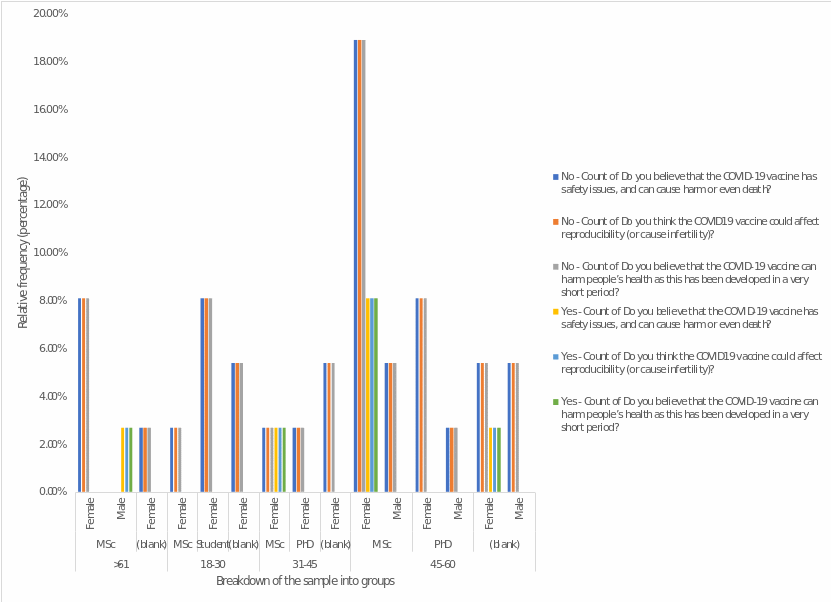
Diagrams of similar complexity are also characteristic of the study of deep connections between demographic and conspiracy dimensions. One need only turn to Figure 5 to discover some of the intriguing patterns. This chart compares the relationship of answers to questions #13 and #15 to demographic values. One can see that the yes/yes type combinations are extremely rare — indeed, only one woman in the 45-60 age group answered that way. Most people (94.74 percent) responded negatively to two questions at once, and only one person who responded negatively to question #13 did not respond to question #15. In addition, in all age groups except 45 to 60, respondents were not inclined to answer these conspiracy questions in the affirmative. Consequently, a general conclusion can be drawn that the hypothesis of 5G, nanochips, and population control are not expected.
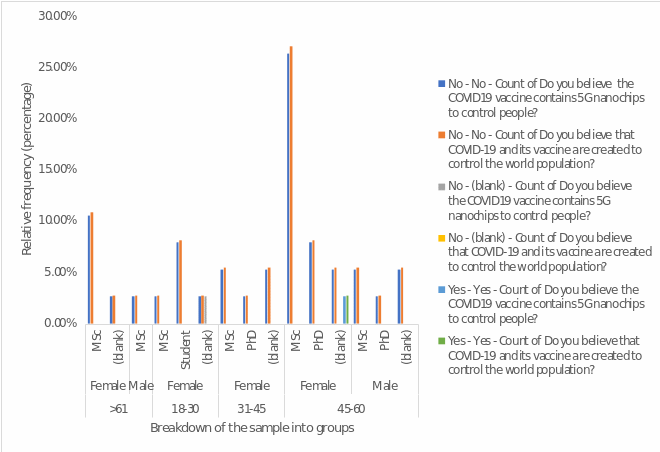
However, if one turns to Figure 6, one can see that negative response to questions #16 and #18 was also a popular trend among respondents. Again, only one uneducated woman in the 45 to 60 group answered affirmatively to both questions at once. However, it is also noticeable that a woman in the 31-45 group with a PhD education also answered affirmatively to question #18 about the role of vaccines as advocacy for peace management. Consequently, the trends of respondents’ general distrust of conspiracy theories persist.
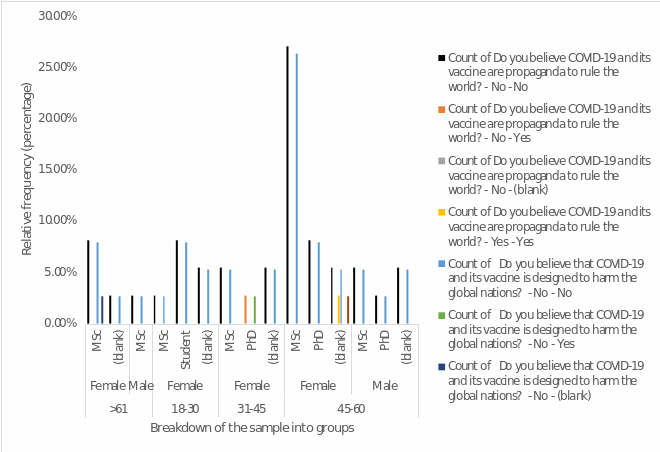
Conspiracy Sources Survey
Although it was shown that respondents did not tend to trust conspiracy theories — possibly due to the fact that they had all been inoculated — they still received information about conspiracy theories through various channels. Question #19 allowed participants to give multiple answers, which meant it made sense as a tool of increased accuracy for determining public sentiment (Checkbox grid, 2020). The histogram in Figure 7 shows that the Internet (65.79 percent) and social media (44.74 percent) were the most frequent sources of conspiracy information, with friends, colleagues, and family members being the least likely to receive this type of information: a combined total of 7.89 percent.
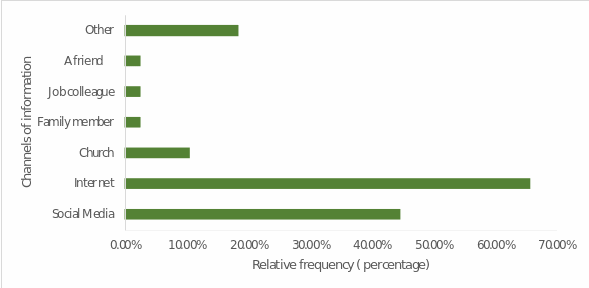
Research on Illness Conditions
One of the questions in the project was to determine the relationship between having medical conditions as a medical reason for not vaccinating. Figure 8 shows that most respondents reported having cardiovascular disease (18.42 percent), diabetes (10.53 percent), and then rheumatologic diseases (5.26 percent). One can see that the cumulative percentage is meaningfully less than a hundred: not all of the participants reported diseases, or they did not have them.
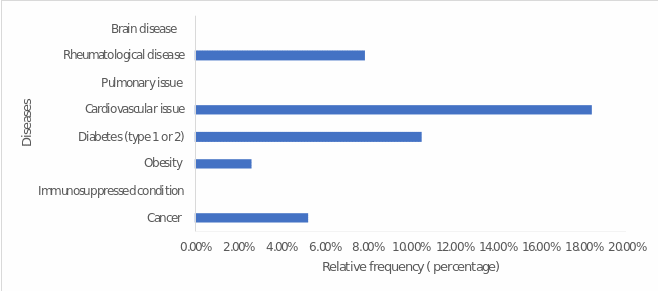
Exploring Reasons for Refusing Vaccinations
Participants were also asked why they refused a vaccine if a health care provider had recommended it. Given that all of the people in the sample are vaccinated, the high rate of “I never refused a vaccine recommended by a healthcare worker” does not seem unobvious. Among other things, respondents could answer that they did not think the vaccine was a necessity (no. = 1), and did not have enough information (no. = 2), and did not think the vaccine was effective (no. = 2).
Table 5. Frequencies of Reasons for Not Vaccinating.
In this sense, it is interesting to measure the gradient of responses about the importance of vaccination on the Likert scale. Table 6 shows that about two-thirds of respondents thought the vaccine was extremely important, and about one-third of sample participants thought the vaccine was simply important. It is noteworthy that none of the respondents said the vaccine was “not necessary.”
Table 6. Estimation of Vaccine Importance by Level.
Finally, to give a complete picture of this sample, it is essential to estimate their COVID-19 incidence according to the interview data. Notably, the data were not verified in any way, and participants did not provide medical records. In addition, all participants agreed to answer this question: it can be seen that 41.11 percent of participants experienced COVID-19 with moderate symptoms, and 39.47 percent of participants did not get sick at all. One respondent, who answered moderate symptoms, additionally wrote that she had had the disease before vaccination.
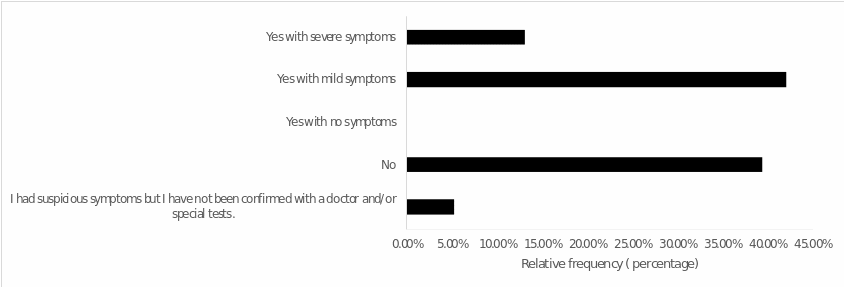
Reference List
Alharahsheh, H.H. and Pius, A. (2020) ‘A review of key paradigms: positivism vs interpretivism,’ Global Academic Journal of Humanities and Social Sciences, 2(3), pp. 39-43.
Apuke, O.D. (2017) ‘Quantitative research methods: a synopsis approach,’ Kuwait Chapter of Arabian Journal of Business and Management Review, 33(5471), pp. 1-8.
Checkbox grid questions explained (2020).
Chyung, S.Y., Roberts, K., Swanson, I. and Hankinson, A. (2017) ‘Evidence‐based survey design: the use of a midpoint on the Likert scale,’ Performance Improvement, 56(10), pp. 15-23.
Esmaeili Abdar, Z., Amirkabiri, A., Haghshenas Kashani, F. and Rabiee Mandejin, M. (2021) ‘Designing professional ethics questionnaire in medical research,’ Alborz University Medical Journal, 10(4), pp. 405-416.
Hunziker, S. and Blankenagel, M. (2021) ‘Cross-sectional research design,’ Research Design in Business and Management, pp. 187-199
Informed consent guidelines & templates (2021).
Jebb, A., Ng, V., and Tay, L. (2021) ‘A review of key Likert scale development advances: 1995–2019’ Frontiers in Psychology, 12, pp. 1-14.
Jolley, D. and Paterson, J.L. (2020) ‘Pylons ablaze: examining the role of 5G COVID‐19 conspiracy beliefs and support for violence,’ British Journal of Social Psychology, 59(3), pp. 628-640.
Privacy, security, and confidentiality of survey data (2020).
Sample size formula (2019).
Vaske, J.J. (2019) Survey research and analysis. Sagamore-Venture. North Federal Drive: Urbana.